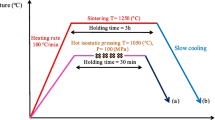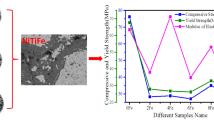Abstract
Ti-42 wt. %Nb powder was prepared by high-energy mechanical milling (HEMM). The particle size distribution (PSD) of the as-milled powder has been investigated using a particle size distribution analyzer. The morphology and microstructure of the as-milled powder have been investigated by scanning electron microscopy (SEM), X-ray diffractometry (XRD), transmission electron microscopy (TEM), and differential thermal analysis (DTA). Also, the corrosion property and biocompatibility of sintered specimens comprising mixed and milled powders have been investigated. The milled powders were sintered using pulse current activated sintering (PCAS). PCAS was employed in order to provide more refined grain size and full density to Ti-42 %Nb alloy on the basis of short sintering time with pressure. The density of the sintered Ti-42 %Nb specimen fabricated using the milled powder increased with increased milling time due to high free surface area and defect density. The density of the sintered Ti-42 %Nb specimen fabricated using as-mixed powder increased with increased sintering temperature up to 950 °C. The microstructure of the sintered Ti-42 %Nb specimen fabricated using 4h-milled powder was composed of Nb-rich and Nb-poor phases that are more refined and homogeneously distributed. The mechanical properties and biocompatibility of the sintered Ti-42 %Nb specimen fabricated using milled powder were superior to those of a commercial, Ti-6wt.%Al-4wt.%V alloy.
Similar content being viewed by others
References
M. Long and H. J. Rack,Biomaterials 19, 1621 (1998).
Y. Sasaki, K. Doi and T. Matsushita,Mater. Technol. 66, 64 (1996).
M. Niinomi,Mater. Sci. Eng. A 243, 231 (1998).
S. G. Steinemann,Sci. and Tech. 2, 1373 (1985).
S. Hanada,2004 Korea-Japan International Symposium on Ti, 5 March. CAMTIC, Jeonju, Korea, (2004).
Y. Okazaki, Y. Ito, K. Kyo, and T. Tateisi,Mater. Sci. Eng. A 213, 138 (1996).
I. H. Oh, N. Nomura, and S. Hanada,Mater. Trans. 43, 443 (2002).
I. H. Oh, H. T. Son, S. H. Chang, H. M. Kim, K. Y. Lee, S. S. Park, and H. Y. Song,J. Kor. Inst. Met. & Mater. 44, 441 (2006).
H. Y. Song, Y. H. Kim, S. H. Chang, and I. H. Oh,Kor. J. Mater. Res. 17, 107 (2007).
D. J. Lee, K. K. Lee, K. M. Lee, and J. Y. Hwang,J. Kor. Foundarymen's Soc. 23, 204 (2003).
I. J. Polmear,Light Alloys, Metallurgical and Materials Science Series, p. 162–208, Edward Arnold, London, (1981).
S. E. Kim, H. W. Jeoung, Y. T. Hyun, Y. T. Lee, C. H. Jung, S. K. Kim, J. S. Song, and J. H. Lee,Met. Mater.-Int. 13, 145 (2007).
Author information
Authors and Affiliations
Corresponding author
Rights and permissions
About this article
Cite this article
Woo, K.D., Lee, H.B., Kim, I.Y. et al. Microstructures and mechanical properties of biocompatible Ti-42 wt.%Nb P/M alloy. Met. Mater. Int. 14, 327–333 (2008). https://doi.org/10.3365/met.mat.2008.06.327
Issue Date:
DOI: https://doi.org/10.3365/met.mat.2008.06.327




